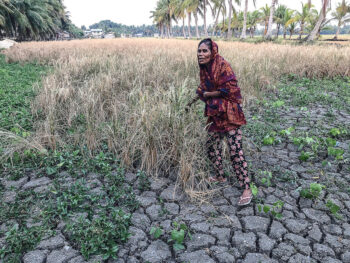NAAWAN, Misamis Oriental (MindaNews / 28 December) – They always come.
Our archipelagic destiny as a country located at the rim of the southern Pacific Ocean makes us naturally vulnerable to the yearly recurring devastating tropical cyclones or typhoons, aside from the equally damaging El Niño and La Niña weather anomaly. Thus, we top in the Germanwatch’s list of countries suffering from extreme weather, earning us the unenviable title as the world’s most disaster-prone country. In the advent of global warming and climate change, our vulnerabilities are becoming acute.
The typhoons, the number of which at times would exceed the letters of the alphabet (an average of 20 / year), are often so wicked and violent that claim thousands of lives and ruin several billion pesos worth of crops and infrastructures.
Typhoons are generally developed in the southern Pacific Ocean. A typhoon forms when winds blow into areas of the ocean where the surface water is warm. These winds collect moisture and rise, while colder air moves in below. This creates pressure, which causes the winds to move very quickly. The winds rotate, or spin, around a center called an eye and move westwards towards land. Location-wise, we are the country destined to suffer first the brunt of a tropical cyclone since time immemorial.
Needless to say, typhoons are a regularly occurring phenomenon in our country. Our current communication and information facilities can already divine days ahead the occurrence of a typhoon, its direction, its strength and speed, the volume of rain it brings, and the moment of landfall. Moreover, there are areas in the country that are known as typhoon paths, precisely because typhoons visit or pass through these places with almost predictable regularity. These typhoon paths, notably in northern Luzon and eastern Visayas, have not changed much through the years despite the recent aberration of Typhoon Sendong (Washi) in 2011 in northeastern Mindanao and Typhoon Pablo (Bopha) in 2012 in Davao Oriental.
Typhoons during the months of June – September usually smash northern and central Luzon. November- December typhoons, on the other hand, rampage the eastern Visayas and the Bicol region.
We definitely cannot stop the typhoons from coming and from wreaking havoc in their path, but we may able to reduce loss of lives and destruction of valuable properties by proactive preparation.
The Disaster Risk Reduction Management Council (DRRMC), the body at the national and local level tasked to plan and execute response to natural calamities, ought to shift major focus from rescue and relief operations to building more disaster-prepared and resilient communities.
For instance, in the wake of typhoon Odette, storm surge wiped out nearly all the human settlements along the coasts of Southern Leyte. The situation offers an expedient opportunity to impose political will in relocating those affected to higher safer grounds, no matter the inconvenience.
The local government units, especially in the typhoon path communities, with support from the national government, should invest in building steel and cement aerodynamic-designed evacuation centers, safe from falling trees, flash floods and storm surge.
In island communities, the LGUs and residents should join hands in planting mangroves in appropriate sites to serve as buffer from strong winds and storm surge.
Education is important in informing people on safety measures and in engaging community effort to reduce the adverse impact of typhoons.
Days before a typhoon, it helps if everyone participate in trimming trees and shrubs in the neighborhood to avoid the hazards of flying branches and toppled trees. Trimmed trees may serve as buffer. The leaves of bananas and the fronds of coconuts may also be sliced off to save the trees from being felled by the winds.
Coconuts are common crops in coastal communities. To save such cash plant from typhoons, there may be a need to start replacing existing crops and those destroyed by the typhoon with fast growing and wind-resistant (dwarf) but good bearing varieties.
It is also advisable to de-clog sewers and drain canals and esteros to minimize occurrence of floods and long-staying flood waters.
Families in typhoon paths should always be prepared for an incoming typhoon. Days before, basic needs, such as some amount of ready-to-eat food, drinking water, clothing and sleeping materials in waterproof containers should have been secured, ready to pick up any time for the impending evacuation.
And it is advantageous to know one’s surroundings and evacuation routes.
If the forecast is a slow-moving typhoon, then expect rain bombs that may cause raging flash and deep waters to follow in the typhoon’s wake. Seek higher grounds.
If it is a strong and fast-moving typhoon, seek strongly-built shelters, away from tall and big trees and beyond the reach of a storm surge.
Finally, it helps to familiarize yourself with the emergency numbers in your locality where assistance may be sought, like the local DRRMC, PNP, LGU Rescue Team, and the community hospital. And do not forget to charge your phone before the disappearance of power.
(MindaViews is the opinion section of MindaNews. William R. Adan, Ph.D. is retired professor and former chancellor of Mindanao State University at Naawan, Misamis Oriental, Philippines.)







